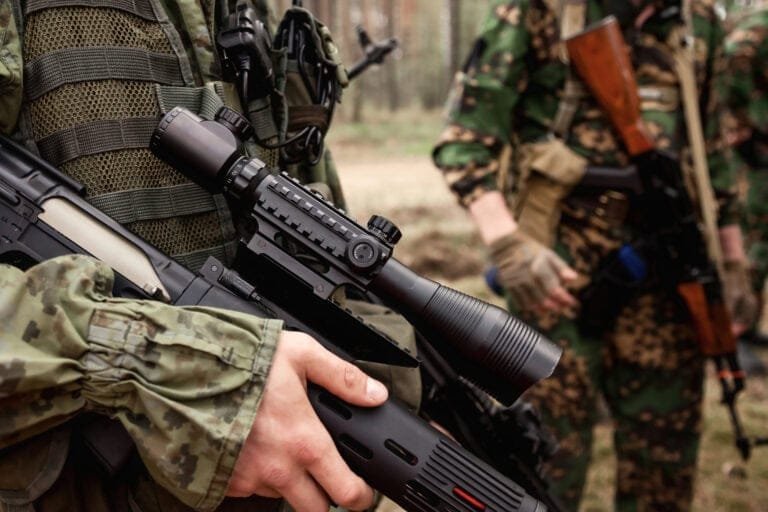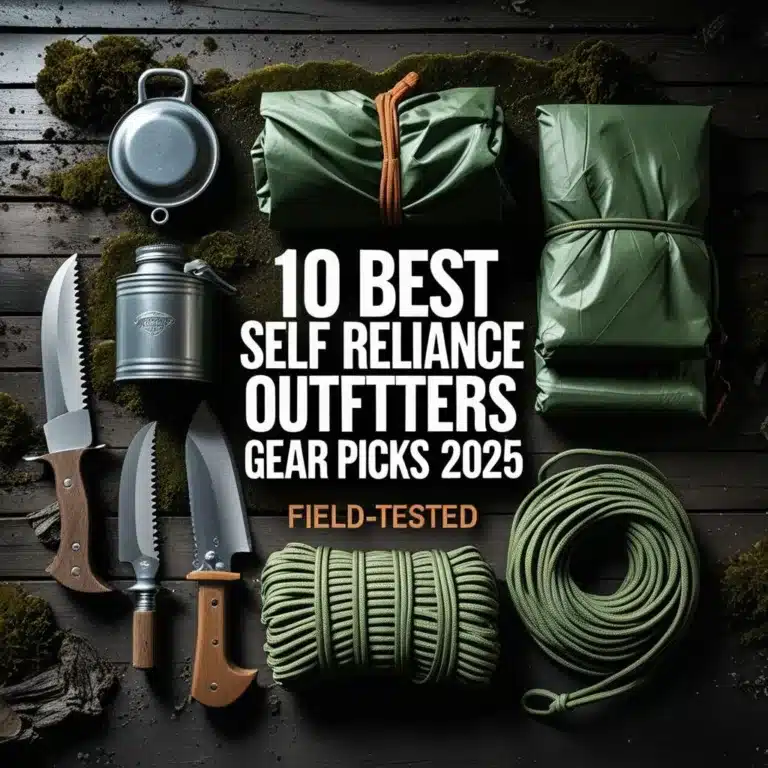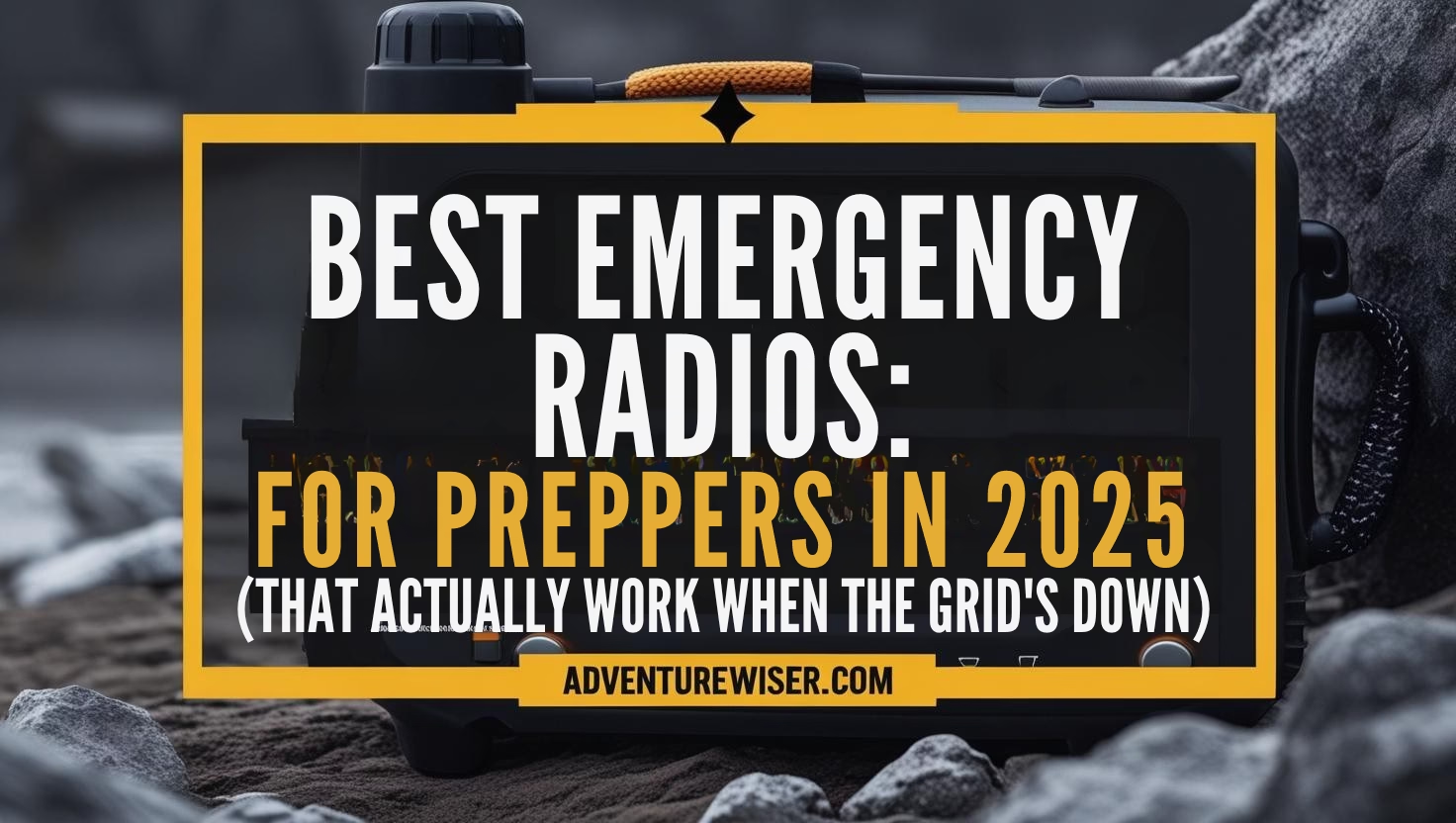
Why Every Prepper Needs the Best Emergency Radios in 2025
Power’s out. Your phone is dead. The storm outside sounds like it’s auditioning for a disaster movie. And your only source of news is your neighbor yelling that “it’s probably fine.”
In a real emergency, information isn’t just nice to have—it’s survival fuel. Having the best emergency radios in your kit means you can get NOAA weather alerts, local emergency updates, and even shortwave signals from halfway across the country.
Whether you’re facing hurricanes, ice storms, or a full-blown grid-down scenario, the best emergency radios keeps you informed when every other device in your life taps out.
Here’s the 2025 lineup of the best emergency radios for preppers—tested, trusted, and tough enough to earn a spot in your bug-out bag.
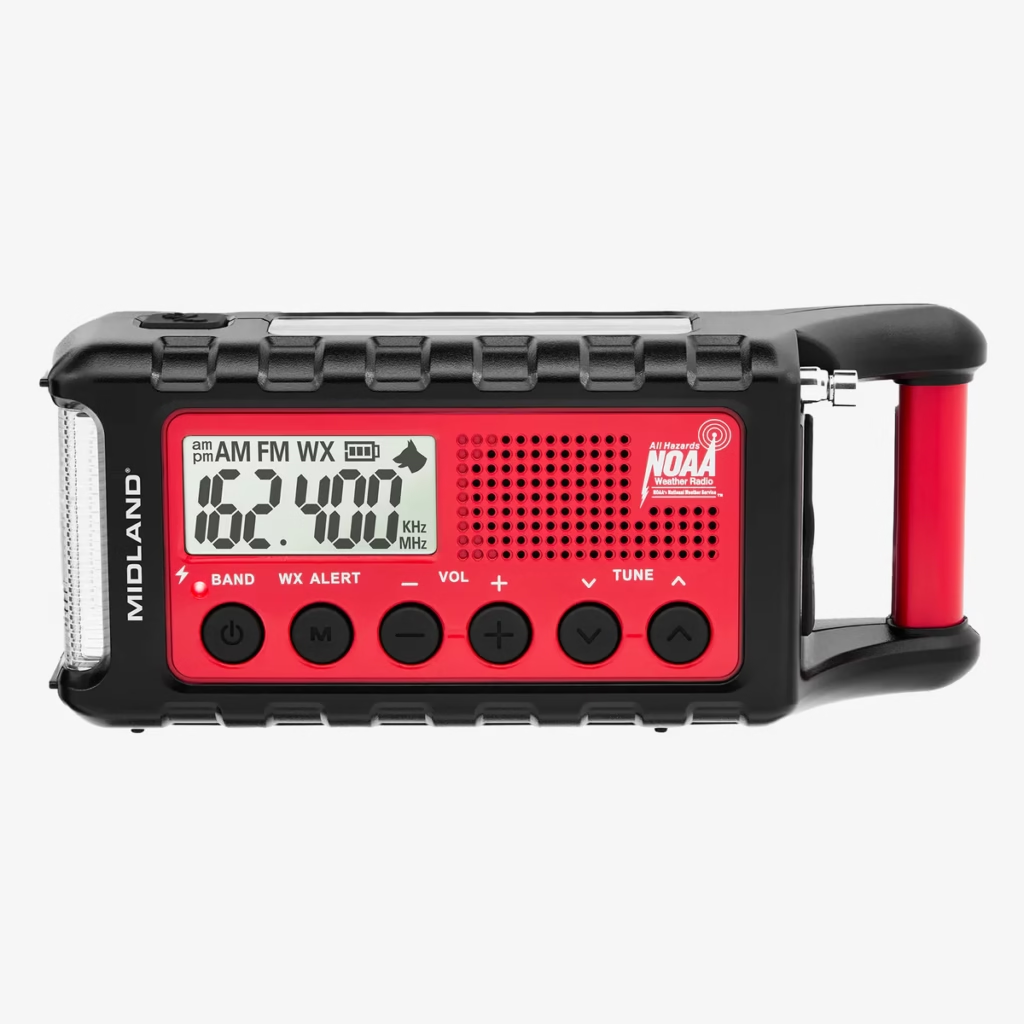
Midland ER310
Reliable, rugged, and ready for anything. With solar, crank, and battery power, NOAA alerts, and a built-in dog whistle, this is the radio you want when the world gets weird.
Pros:Cons:
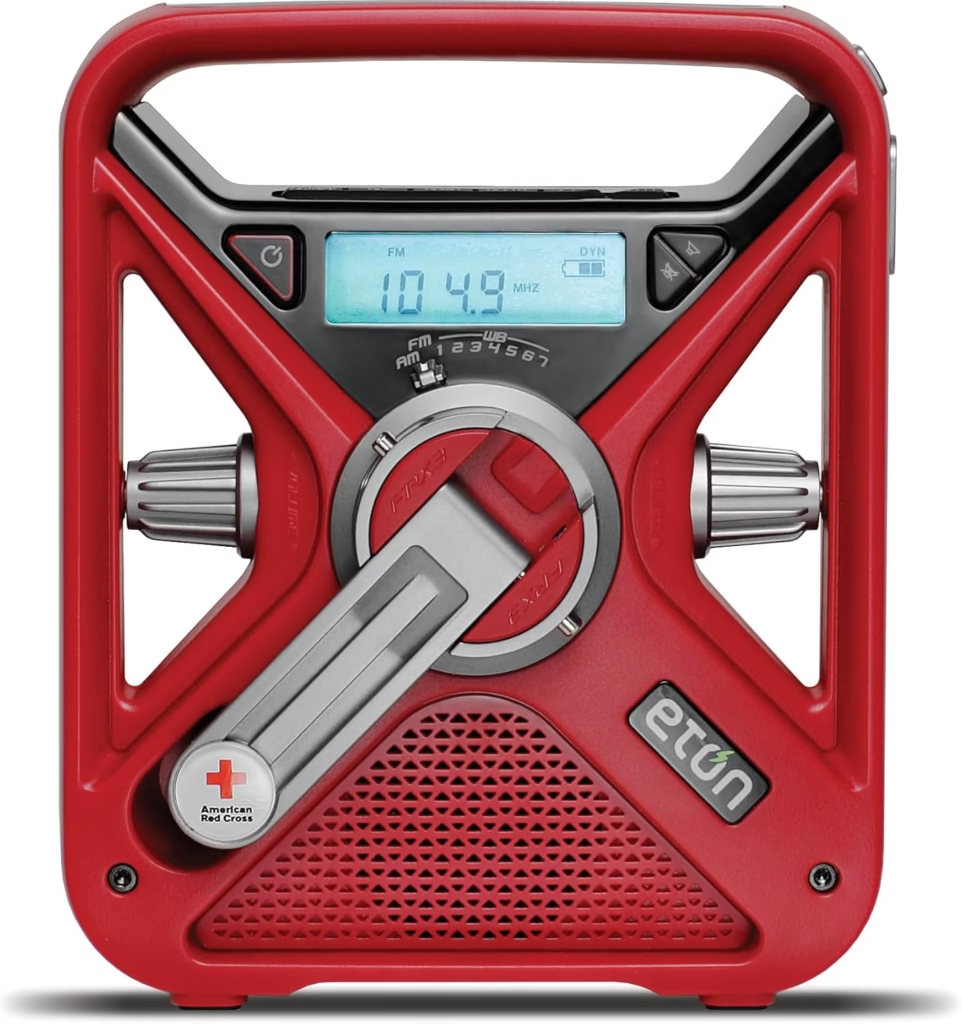
Eton FRX3+
Small enough for your go-bag, big enough to keep you informed. Multiple charging options, SAME alerts, and a built-in flashlight make it a storm-season MVP.
Pros:Cons:
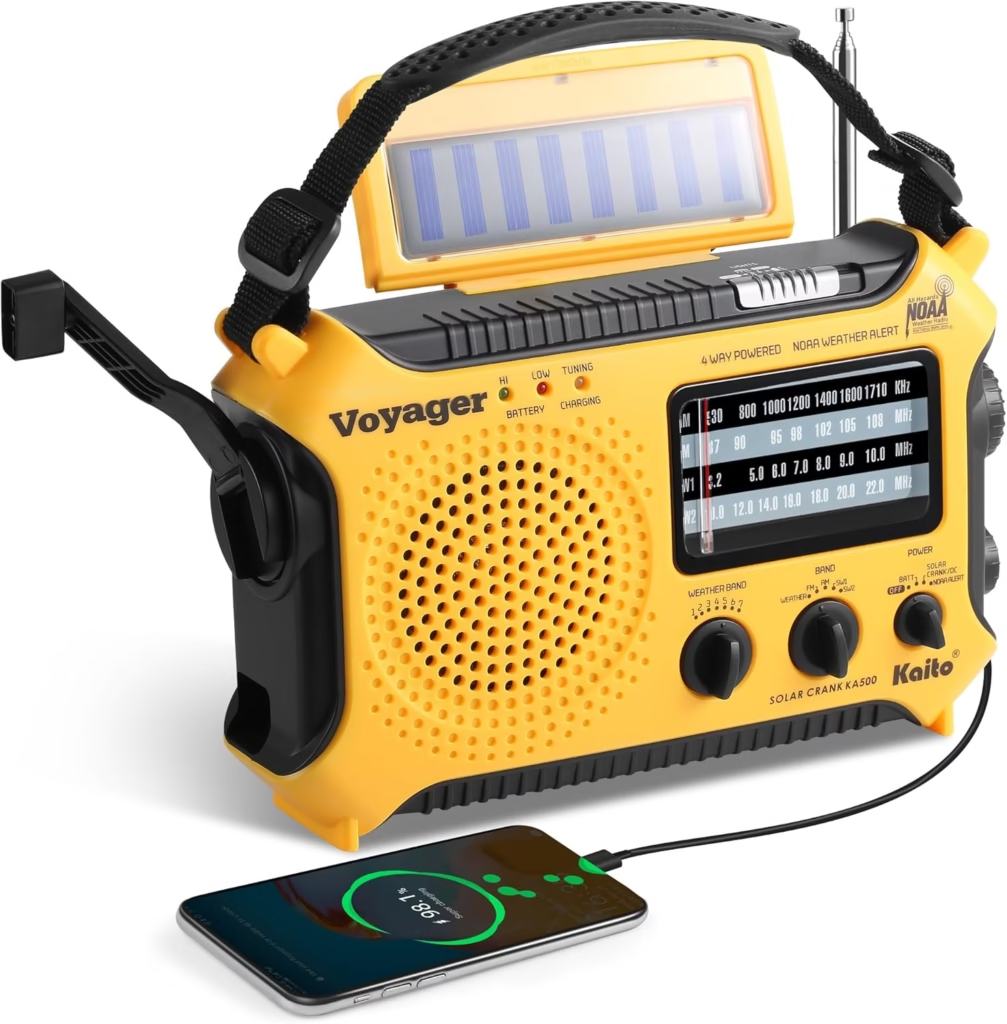
Kaito KA500
Six power sources, shortwave reception, and dual lights mean this radio isn’t just for emergencies — it’s for anyone who likes being in control, even off-grid.
Pros:Cons:
Quick Comparison Table
| Model | Power Options | NOAA Alerts | Price | Best For |
|---|---|---|---|---|
| Midland ER310 | Solar, Crank, Battery | Yes | $$ | All-around survival |
| Eton FRX3+ | Solar, Crank, Battery | Yes | $$ | Storm readiness |
| Kaito KA500 | Solar, Crank, Battery, AC | Yes | $ | Off-grid preppers |
| RunningSnail MD-090P | Crank, Battery | Yes | $ | Budget-friendly |
Best Emergency Radios Reviews
Midland ER310 – The All-Around Prepper Pick
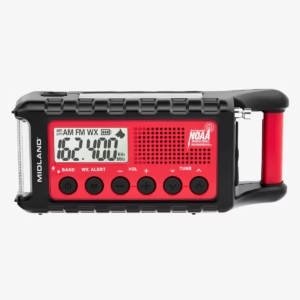
Why It Rocks:
This thing is basically the Swiss Army knife of emergency radios — if the Swiss also issued storm alerts and charged your phone. The ER310 packs multiple charging options (solar, hand crank, and rechargeable battery), NOAA weather alerts that actually cut through the noise, a built-in LED flashlight bright enough to light your whole tent, and, yes, an ultrasonic dog whistle. That last feature might sound like a gimmick until you realize it can be used in search-and-rescue situations or to scare off unwanted four-legged visitors. Overkill? Maybe. But in a survival situation, I’ll take “over-prepared” over “under-ready” any day.
Pros:
- Rugged build that feels like it could survive a drop from your tailgate.
- Loud, clear reception for NOAA weather and AM/FM.
- Flashlight with SOS strobe for signaling in low visibility.
- USB charging to top off your phone or GPS when the power’s out.
- Easy-to-use controls, even when your hands are cold.
Cons:
- On the heavier side for a minimalist bug-out bag.
- Solar charging works, but slowly — think “backup” not “primary.”
- USB port won’t fast-charge larger devices.
- Not waterproof — keep it out of heavy downpours.
- Price tag is higher than bare-bones models, but you get what you pay for.
Eton FRX3+ – Storm-Ready and Compact
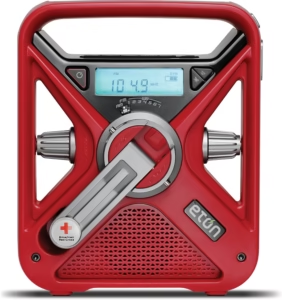
Why It Rocks:
If the Midland is the burly survivalist, the FRX3+ is the nimble scout. This radio is compact enough to slip into your go-bag without hogging space for food, ammo, or coffee rations. It has multiple charging options (crank, solar, USB), SAME technology for location-specific weather alerts, and a built-in flashlight with a red emergency beacon that’s perfect for signaling without blinding your campmates. It’s not as overbuilt as the ER310, but it makes up for that with portability and price. When storms roll in, this is the little guy you’ll be glad is in your pack.
Pros:
- Compact and lightweight — a true grab-and-go option.
- SAME alerts mean you only get weather warnings for your area.
- Multiple power sources keep it running in various scenarios.
- Flashlight and red beacon built-in for night signaling.
- More affordable than feature-loaded big brothers.
Cons:
- Smaller speaker — audio is clear, but not campsite-filling.
- Solar panel is tiny; cranking works better for quick charges.
- Short crank handle makes long sessions a workout.
- Limited battery life compared to larger models.
- Small buttons aren’t glove-friendly.
Kaito KA500 – Feature-Packed for Off-Grid Living
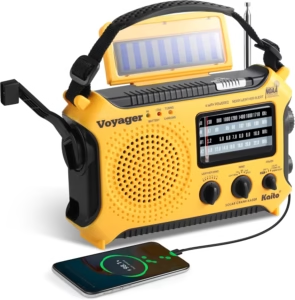
Why It Rocks:
If you’re the kind of prepper who believes “too many options” is a myth, the KA500 is your jam. With six power sources — crank, solar, USB, AA batteries, AC adapter, and DC car charger — this thing will run even if you’re in the middle of nowhere with no sunlight and a dead battery stash. It receives AM/FM, NOAA weather, and even shortwave bands, so you can eavesdrop on broadcasts halfway across the world if you’re bored at camp. The larger solar panel charges faster than most, and the dual lighting (flashlight + reading lamp) makes it great for both emergencies and daily camp use. It’s bigger and heavier, sure, but it’s a workhorse for long-term off-grid living.
Pros:
- Six different power options for maximum redundancy.
- AM/FM, NOAA, and shortwave reception — because information is survival.
- Larger solar panel for faster charging.
- Dual lighting — flashlight plus reading lamp.
- Rugged housing with a solid grip.
Cons:
- Bigger and heavier — not ideal for ultralight packs.
- Tuning dial feels old-school and requires precision.
- Speaker is functional, not rich in sound.
- No SAME technology, so you get all alerts (relevant or not).
- Slight learning curve to master all the features.
RunningSnail MD-090P – Budget-Friendly Lifeline
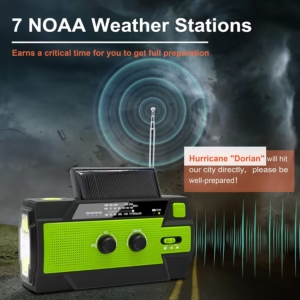
Why It Rocks:
If your budget’s tight but you still want a lifeline when the skies turn ugly, the MD-090P has your back. This little workhorse offers three charging methods (hand crank, solar, and USB), NOAA weather alerts, and a flashlight bright enough to find the bug spray you swear was “right there.” There’s even a reading lamp to keep you sane while waiting out a storm. It’s not the most rugged or fully loaded radio on the market, but for the price, it’s hard to beat as an entry-level prepper pick.
Pros:
- Extremely affordable — a true budget lifesaver.
- Multiple charging options for flexibility.
- NOAA weather alerts keep you in the loop.
- LED flashlight and fold-out reading lamp in one.
- Lightweight and portable for grab-and-go kits.
Cons:
- Build quality is good for the price, but not tank-like.
- Smaller battery capacity compared to premium models.
- Solar charging panel is tiny — cranking works better.
- Speaker sound is passable, not powerful.
- Lacks some premium extras like SAME alerts or shortwave.
How to Choose the Best Emergency Radios
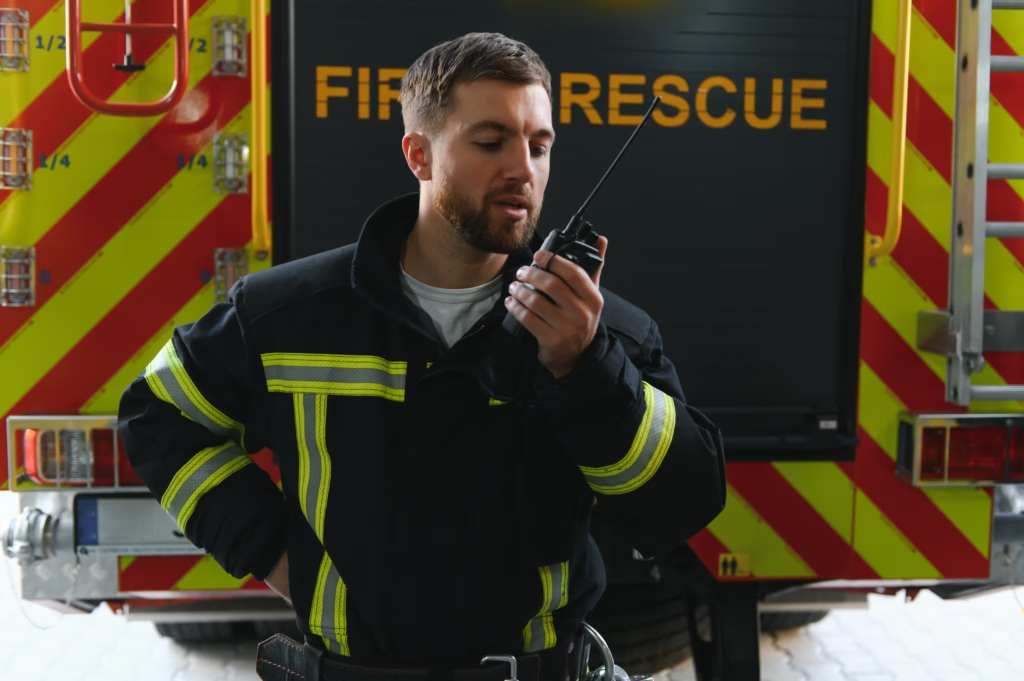
Picking the best emergency radios isn’t about grabbing the first thing Amazon throws at you. It’s about knowing what features actually matter when you’re freezing in the dark, wondering if that noise outside is wind… or something else. Here’s what to look for:
1. Power Sources: More Is Always Better
If a radio only has one way to charge, it’s a gamble. You want crank power for endless backup, solar panels for sunny days, and battery options for when you can’t crank or the sun’s playing hide-and-seek. A built-in rechargeable battery is nice, but it should never be your only option.
2. Reception Quality: Clarity Beats Static
Your best emergency radios should pull in NOAA Weather Band channels without sounding like a swarm of angry bees. AM/FM gives you local news, while shortwave lets you hear broadcasts from other regions—useful if you want the big picture during a disaster.
3. Durability: Built for the Bottom of a Bug-Out Bag
Rain, dust, drops—it should handle all of it. Look for water-resistant, shock-resistant builds that won’t fall apart after a couple of knocks. A radio that can survive your clumsy camping buddy can survive most emergencies.
4. Extra Features: The Survival Cherry on Top
A built-in flashlight is a no-brainer. USB device charging means your phone gets one last lifeline. An SOS alarm can get you noticed if you’re stranded. These extras turn your best emergency radio from “nice-to-have” into “why didn’t I buy this sooner?”
Prepper Pro Tips for Using Your Best Emergency Radios
1. Make It Grab-and-Go Gear
Your best emergency radio won’t do you any good if it’s buried under a pile of camping junk in the garage. Store it in your bug-out bag, emergency kit, or somewhere you can grab it in under ten seconds. In a crisis, you won’t have time to play “find the radio” under a stack of half-empty propane canisters.
2. Test It Like Clockwork
Reception and charging features aren’t “set it and forget it” — they need a check-up. Every three months, crank it, solar charge it, and make sure NOAA channels come through loud and clear. That’s how you find problems before you’re in the middle of a blackout.
3. Pack Backup Power Like a Pro
Keep extra batteries in a waterproof pouch or vacuum-sealed bag. A dead radio in an emergency is just a paperweight — and paperweights won’t warn you about the tornado bearing down on your county.
4. Learn Your Local NOAA Frequency Now
Don’t wait until the storm sirens are wailing. Find your local NOAA weather frequency today and write it on a piece of tape right on the back of your radio. That way you or anyone else can tune in instantly, even in the dark.
Wrapping Up – Don’t Wait Until the Storm Hits
When the grid goes down, seconds matter—and those seconds decide whether you stay calm or spiral into chaos. The best emergency radios for preppers aren’t just about catching the evening weather report. They’re about giving you the information you need to make smart, fast, and possibly life-saving decisions when everything else around you has gone dark.
Think about it: storms, blackouts, wildfires, civil emergencies—none of them send a polite calendar invite. If you wait until the wind’s already howling and the shelves are stripped bare, you’re too late. The best emergency radio isn’t something you buy for fun—it’s something you buy so you’re never blindsided.
So, pick one from this list, stash it in your emergency kit, and run a quick test every few months. Learn the NOAA channel for your area. Make sure your backup power works. Because when the lights go out and the cell towers drop, the last thing you want to hear is silence.
Heads-Up, Fellow Preppers:
Some links in this post are sponsored or affiliate links. If you click and buy, I may earn a small commission—enough to restock my peanut butter and maybe add one more can of chili to the stash. I only recommend gear I trust, use, and would hide in a bug-out bag.

